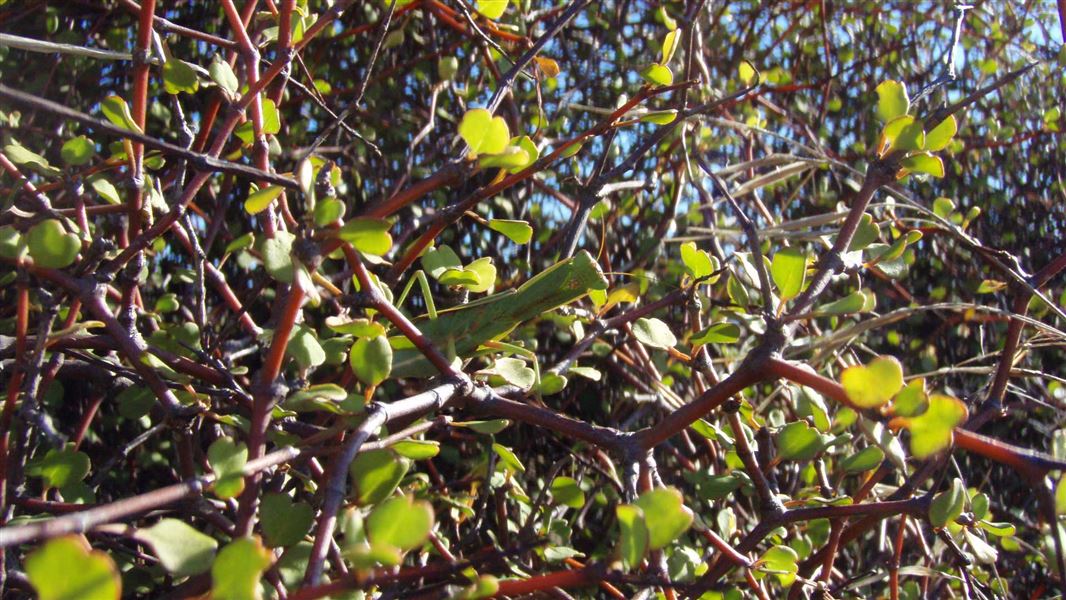The tororaro is typical of a large group of New Zealand plants that have become extremely rare following human settlement. It has a threat status of 'Nationally Endangered'.
Facts
The species acts as an important host for insects. These insects then become a significant food source for many native species of bird and lizard. The tororaro also has valued medicinal properties.
To Māori, these aspects make the shrub a taonga species of cultural and spiritual importance.
The tororaro is a highly unusual plant, and is easily recognized by its interlaced, zigzag branches and lime-green heart-shaped leaves.
Ecology
The shrub produces delicate white flowers during summer and autumn. Male and female flowers occur on separate plants though a few male plants occasionally set seed.
Fruits are small and white, possibly making up part of lizards' diet.
The plant may grow to 4 m in height, and lives for up to 80 years.
Habitat
The tororaro has a deep root system that allows it to survive in very dry conditions.
The shrub is commonly found on free-draining, highly fertile areas such as coastal land and river flats. Favoured spots include coastal and alluvial terraces, rocky bluffs and hill slopes.
The tororaro occurs in central and eastern New Zealand. Its distribution extends from the eastern Wairarapa coastline in the North Island, down to Kaitorete Spit in the South Island.
The total population in the wild is estimated to be 2,800 plants. The largest population is on Kaitorete Spit, where there are around 2,500 plants.
The specialist habitats occupied by the tororaro suggest that it was never abundant in New Zealand.
Threats
Habitat fragmentation and destruction
Stock presence and agricultural development have reduced shrub populations. Populations have also become isolated, leading to limitations on seed dispersal and colonisation.
Predation and trampling
Rodents eat seeds, while snails and slugs are thought to eat any seedlings which may germinate. The shrub is also vulnerable to browsing by introduced animals.
In many places plants occur singly or in small single sex groups preventing seed production.
Disease, single-sex populations, competition, and damage caused by river gravel extraction are less significant causes of decline.
Potential for recovery
The recovery potential of the tororaro is excellent.
This is because the species is easily cultivated, grows well from seed and cuttings, and exhibits an immediate response to management.
DOC's work
Past conservation efforts
Three populations of tororaro at Cape Campbell, Balmoral Conservation area, and Kaitorete Scientific Reserve are legally protected, with restoration planting being carried out at each site.
Samples of plants from the North Island, Marlborough and Canterbury are in cultivation. A number of institutions have 'insurance' plantings, and several nurseries also have plants.
The tororaro is also promoted to the public as a garden plant for hedging.
Recovery Plan
A DOC Shrubby tororaro Recovery Plan sets out a series of steps that will promote the recovery of the tororaro. It also outlines different management options, and a work plan.
The plan also provides opportunities for consultation between the DOC and tangata whenua, in recognition of the species' cultural significance to Māori.
The long-term vision of the recovery plan is to: 'Manage shrubby tororaro and promote interest in its recovery so that viable populations of the species and its associated communities are restored, self-sustaining and protected in the wild throughout the natural range of the species.'
Shrubby tororaro (Muehlenbeckia astonii Petrie) Recovery Plan 2000-2010 (PDF, 352K)
You can help
DOC welcomes any comments or suggestions you may have about the conservation of the shrubby tororaro. You can contact any DOC office.
